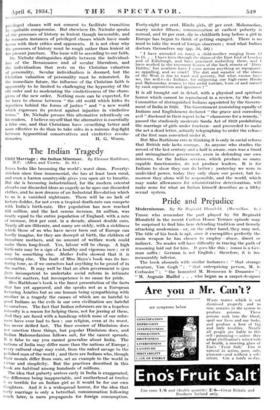Pride and Prejudice Modernismus. By Sir Reginald Blomfield. (Macmillan. 6s.)
THOSE who remember the part played by Sir Reginald Blomfield in the recent Carlton House 'Terrace episode may be surprised to find him here defending tradition and fiercely attacking modernism—or, on, the other hand, they may not. The title of his book is apt, since it exemplifies perfectly the main weapon he has chosen to employ—abuse, direct or indirect. No reader will have difficulty in tracing the path of reasoning laid out for him. It goes like this : ismus is a Ger- man suffix : German is not English ; therefore, it is im- measurably inferior.
The book abounds with similar instances : " that strange creature, Van Gogh " ; " that enterprising person, M. le Corbusier " ; " the lamented M. Rousseau he Douanier " ; " M. Auguste Maillol . . . who began as a carpet-desig nee
and took to sculpture in middle life " (why, by the way, spare Gauguin, who did something very similar ? But perhaps stockbrokers arc more respectable than carpet-designers) ; " Russia and those weird new Eastern states." This sort of thing would seem more suited to the pages of a school maga- zine than to a book by one of Sir Reginald Blomfield's emin- ence. If we look for logical argument, we are disappointed.. By dint of quoting several writers he is able to set out various conflicting remarks about modernism ; and this he appears to think disposes of modernism itself. On page 76 he advances against it the unfortunate fact that in the building of the Potsdam Observatory, which was designed for concrete, brick had to be largely used owing to a shortage of steel rods in the difficult post-War years. On page 71 he speaks of functionalism and symbolism (which has nothing to do with modernism) as though they were the same thing.
In actual fact it is impossible to discover from this book what modernism is : the only conclusion one can draw is that it is anything approximately contemporary of which Sir Reginald Blomfield disapproves. He approves, for instance, of a modern church at Eltham because it reminds him of another at Albi and wakes for him, as he puts it, " those dear echoes of the past that linger in the memory like half-.remem- bered music." But most modern houses he finds " like an oblong box on posts " or " as if they were built of the smooth white icing of birthday cakes," and their rooms (with a rarely original flight of simile) " like the operating-rooms of a hospital." Concrete he finds " no more suggestive as a material than a lump of clay "—a parallel that should appeal to sculptors—and he makes a number of unsupported and unsupportable assertions about building materials in general.
Modern painting pleases him no more than modern archi- tecture, and he devotes a tiresomely large number of pages to describing in comic style the contents of various pictures as viewed through his eyes in contradistinction to their titles. One thought that this particular vein of humour had been exhausted in the columns of the cheap Press when the pictures were originally exhibited. He allows that " there was a time when Picasso drew exceedingly well," yet does not stop to consider that this artist, who in the opinion of most educated people ranks at least as high in his profession as Sir Reginald in his, may know rather more exactly than a dilettante observer just what he is doing. Sculptors and musicians fare no better, and, in letters, the quotation of a few puerile sentences—mainly from across the Atlantic—is held to be adequate grounds for an irascible attack on all " modern " writing.
It will be seen that there is little " meat " in this book for any serious student of modernism. Had the author seen fit to control his choler and write a critical study of the subject, his great experience and ripe judgement would have claimed our careful attention ; by his present writing he can only be said to have done his cause a considerable disservice.
G. M. BOUMPIIREY.









































 Previous page
Previous page